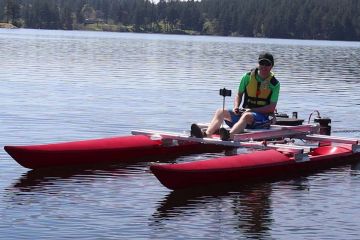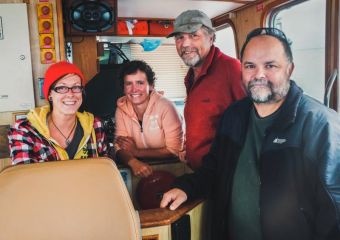UVic Engineers Developing Robots For Inner And Outer Space
The ocean, teeming with life, and the lifeless reaches of outer
space are both airless, low-gravity environments into which it is
dangerous and expensive to send humans. This similarity underlies the
work done by mechanical engineering professors Inna Sharf and Meyer
Nahon at UVic's Space and Subsea Robotics Lab.
Sharf administers space robotics, Nahon is in charge of undersea robotics, and both do some work in aeronautics. The two, a married couple, came to UVic in 1991.
The subsea studies include research and development of remotely operated underwater vehicles (ROVs) -- which perform such underwater tasks as offshore oil platform inspection, cable repair and scientific exploration -- and autonomous underwater vehicles (AUVs), which have no cables connecting them to the operator.
On the space robotics side, Sharf and her students recently completed a project for MDR (previously known as SPAR Aerospace), the company that built the space shuttle Canadarm. Systems like the Canadarm are designed for use in zero-gravity conditions and, on earth, they can't even support their own weight, much less move. Because of this, they can only be tested by simulation. MDR developed computer simulations to test how its systems will work in space, and the UVic lab's job was to test the computer simulations to find out how accurately they represent real motion.
Nahon also works extensively with computer simulations. He and some of his students are developing a simulation facility for the design and control of AUVs. It will enable designers to test the stability of a proposed vehicle before building a prototype model.
"It allows designers of a real undersea vehicle to change their configurations, and then simulate flying it to see what happens," says undergraduate student Curran Crawford, who integrated a joystick with the program, enabling users to pilot the simulated vehicle in a realistic way. The simulation may eventually be used in conjunction with real AUVs, so that operators can "see" what is going on as they control the vehicles from above water.
Another of Nahon's projects involves ROV slack cables, which transmit power and information to the vehicles when they are underwater. These cables often get caught or tangled. Nahon and his students test their simulations against real-world conditions using a mini slack-cable ROV in UVic's McKinnon pool. This allows them to see whether their simulations represent the motion of the cable accurately.
Sharf is working with universities in Canada and Europe to establish a virtual laboratory that will enable users from partner institutions to access the robotics facility remotely over the Internet. The Canada Foundation for Innovation recently awarded $711,080 for a new experimental laboratory for Instrument Development in Astrophysics, a project led by Sharf. The lab will test instruments for future generations of ground-based and space optical and radio telescopes.
Nahon is involved in an associated project, the Large Adaptive Reflector, a giant steerable radiotelescope.
Both Nahon and Sharf receive a large portion of their funding from the Natural Sciences and Engineering Research Council of Canada (NSERC). This funding has helped pay for general operations, equipment and the hiring of students.
Sharf administers space robotics, Nahon is in charge of undersea robotics, and both do some work in aeronautics. The two, a married couple, came to UVic in 1991.
The subsea studies include research and development of remotely operated underwater vehicles (ROVs) -- which perform such underwater tasks as offshore oil platform inspection, cable repair and scientific exploration -- and autonomous underwater vehicles (AUVs), which have no cables connecting them to the operator.
On the space robotics side, Sharf and her students recently completed a project for MDR (previously known as SPAR Aerospace), the company that built the space shuttle Canadarm. Systems like the Canadarm are designed for use in zero-gravity conditions and, on earth, they can't even support their own weight, much less move. Because of this, they can only be tested by simulation. MDR developed computer simulations to test how its systems will work in space, and the UVic lab's job was to test the computer simulations to find out how accurately they represent real motion.
Nahon also works extensively with computer simulations. He and some of his students are developing a simulation facility for the design and control of AUVs. It will enable designers to test the stability of a proposed vehicle before building a prototype model.
"It allows designers of a real undersea vehicle to change their configurations, and then simulate flying it to see what happens," says undergraduate student Curran Crawford, who integrated a joystick with the program, enabling users to pilot the simulated vehicle in a realistic way. The simulation may eventually be used in conjunction with real AUVs, so that operators can "see" what is going on as they control the vehicles from above water.
Another of Nahon's projects involves ROV slack cables, which transmit power and information to the vehicles when they are underwater. These cables often get caught or tangled. Nahon and his students test their simulations against real-world conditions using a mini slack-cable ROV in UVic's McKinnon pool. This allows them to see whether their simulations represent the motion of the cable accurately.
Sharf is working with universities in Canada and Europe to establish a virtual laboratory that will enable users from partner institutions to access the robotics facility remotely over the Internet. The Canada Foundation for Innovation recently awarded $711,080 for a new experimental laboratory for Instrument Development in Astrophysics, a project led by Sharf. The lab will test instruments for future generations of ground-based and space optical and radio telescopes.
Nahon is involved in an associated project, the Large Adaptive Reflector, a giant steerable radiotelescope.
Both Nahon and Sharf receive a large portion of their funding from the Natural Sciences and Engineering Research Council of Canada (NSERC). This funding has helped pay for general operations, equipment and the hiring of students.
-- 30 --
In this story
Keywords: robotics, engineering, astronomy



